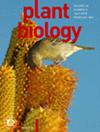Isotope evidence for partial mycoheterotrophy and trophic flexibility in the arbuscular mycorrhizal green plant Gentiana zollingeri
IF 3.6
3区 生物学
Q1 PLANT SCIENCES
引用次数: 0
Abstract

丛枝菌根绿色植物龙胆部分异养和营养柔韧性的同位素证据。
丛枝菌根(AM)关联是陆地生态系统的核心,通常促进植物有机碳与真菌矿物营养物质的交换。完全真菌异养,即植物从AM真菌中获得所有碳,广泛存在于许多无叶绿素植物类群中,如龙胆科的Voyria和Voyriella。然而,部分真菌异养的程度和生态意义,其中绿色AM植物补充真菌碳的光合作用,仍然存在争议。本研究利用13C和15N稳定同位素分析研究了龙胆科植物龙胆(Gentiana zollingeri)的营养模式,重点研究了同位素富集与叶片比(叶片生物量相对于茎部总生物量)的关系。龙胆的13C和15N显著高于自养参考植物,表明其对真菌来源的碳和氮的依赖。13C富集与叶片比呈负相关,表明富集反映的是对真菌的依赖,而非其他生理性状。值得注意的是,地下茎的13C富集程度与完全真菌异养龙胆科相当,表明其主要由真菌碳组成。这些发现支持了G. zollingeri采用灵活的营养策略,根据光合能力调整真菌依赖性的假设。虽然仅适度的13C和15N富集不能证实部分真菌异养,但结合稳定同位素数据和生态生理指标(如13C富集与叶比负相关)的综合方法有力地支持了真菌在G. zollingeri中的碳获取。类似的框架将有助于严格评估其他具有微妙同位素富集的巴黎型AM植物的部分分枝异养性。
本文章由计算机程序翻译,如有差异,请以英文原文为准。
求助全文
约1分钟内获得全文
求助全文
来源期刊

Plant Biology
生物-植物科学
CiteScore
8.20
自引率
2.60%
发文量
109
审稿时长
3 months
期刊介绍:
Plant Biology is an international journal of broad scope bringing together the different subdisciplines, such as physiology, molecular biology, cell biology, development, genetics, systematics, ecology, evolution, ecophysiology, plant-microbe interactions, and mycology.
Plant Biology publishes original problem-oriented full-length research papers, short research papers, and review articles. Discussion of hot topics and provocative opinion articles are published under the heading Acute Views. From a multidisciplinary perspective, Plant Biology will provide a platform for publication, information and debate, encompassing all areas which fall within the scope of plant science.
 求助内容:
求助内容: 应助结果提醒方式:
应助结果提醒方式:


